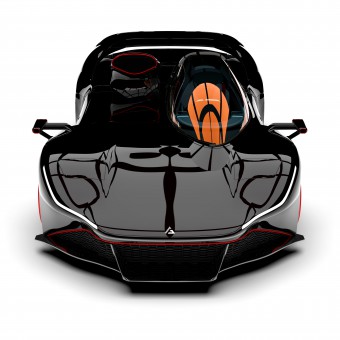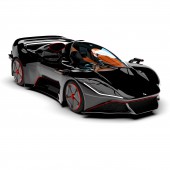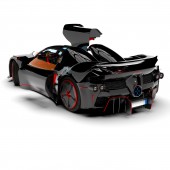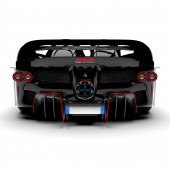
| THE AWARD |
| CATEGORIES |
| REGISTRATION |
| SUBMIT YOUR WORK |
| ENTRY INSTRUCTIONS |
| TERMS & CONDITIONS |
| PUBLICATIONS |
| DATES & FEES |
| METHODOLOGY |
| CONTACT |
| WINNERS |
| PRESS ROOM |
| GET INVOLVED |
| DESIGN PRIZE |
| DESIGN STORE |
| THE AWARD | JURY | CATEGORIES | REGISTRATION | PRESS | WINNERS | PUBLICATIONS | ENTRY INSTRUCTIONS |
Nera Asimmetrica Hybrid Hypercar by Andrea Grosso |
Home > Winners > Design #150169 >Interview |
 |
|
FS: What is the main principle, idea and inspiration behind your design?
AG: The main principle behind the Nera Asimmetrica Project and in general of the whole Symmetry Project was to make simple and multimodal a concept that is often done in a complex and standardized way, taking away the excitement and desire to experiment that has always been in the DNA of racing and great designers. The sources of inspiration to make the modular chassis design at the heart of this project possible were many. Starting from WEC cars to Formula 1 single-seaters, but also cars such as the Pagani Utopia, for example, thanks to their structure, provided me with interesting cues to follow in order to come up with the solutions we decided to implement within this project. Above all, however, there is one concept that, outside of technique, has guided the entirety of my design experience: Reinterpreting the concept of solitude. During the months of the pandemic I experienced what it really means to be lonely, enclosed in a bubble of isolation, and this led me to think about how to capture loneliness, how to shape it, transform it, and be able, in a world made up of only one person inside a cockpit, to best reinterpret the concept of a single-seater. The interiors of these cars are like shells, like cockpits of fighter planes, and everything has to be at the service of the pilot or the passenger, everything has to be comfortable, handy and easy to use. That was the real nature and inspiration of my project, to create something around the figure of the human being. To create something that would envelop them, that would protect them, that would fill them with positive, captivating emotions, and that this set of processes would happen with every kind of interaction that they may experience in the machine within which they are.
FS: What has been your main focus in designing this work? Especially what did you want to achieve?
AG: Certainly the first goal I had set for myself was to be able to create a completamernt project on my own, something that involved a little bit of all areas of the car, that combined both the emotional, technical, and physical interactions of the design, along with the hypothetical ones to bring to life a creation that was both exploitable and at the same time represented my style, what I like, what I would like my future designs to have as well. To create my own signature, my own "vision" that is highly visible and characteristic of my designs, something that would set me apart from the rest of the other designers. I believe that by making this car, a child of my studies of years past, I was able to show how old designs of the past, reinterpreted and modernized, can still be incredibly appealing, bringing elegance, minimalism and style to a world now far removed from the concept of simple and functional.
FS: What are your future plans for this award winning design?
AG: Right now I am using it as a stepping stone to launch my career as a Designer, using it as a business card to gain publicity and recognition, this is so that I can gain some prestige and references that will be useful in finding employment in the industry, as well as making a name for myself in the automotive design community. The Symmetry Project for the moment is a showcase, a big billboard that can show what I am capable of. Definitely, for my sentimental side, I would love for someone to invest in this project, or buy it, so I can make it real, physically build scale models and prototypes, but I dream by taking baby steps, one at a time, trying to be realistic. You have to know that I am a Designer literally came out of nowhere and appeared on the scene thanks to this award trying to make a life for myself again thanks to the design world, the first thing I want to achieve is to make this profession for me a sustainable job thanks to the prestige gained from this award, right now I want my homeland and the world to know that I am here and that I am ready.
FS: How long did it take you to design this particular concept?
AG: It took me at least 6 months to arrive at the final shape, because the project was interspersed with other projects I have in the pipeline that saw the light of day while the Nera Asimmetrica was being gradually shaped and modified in its parts. I say this because unfortunately the current result is very different and undoubtedly better than the result that I had to enter in the competition in spite of myself. I had little time because of the deadline and I was able to do what I could, but afterwards I continued to work on the project, improving it and finishing what I had not been able to complete due to lack of time. I think its potential was higher than what it was able to achieve, but I am still happy because it will attract attention anyway.
FS: Why did you design this particular concept? Was this design commissioned or did you decide to pursuit an inspiration?
AG: I have always been fascinated by the 80s/90s in terms of the design of prototypes and sports cars, and I wanted, following the inspiration of the great masters of the time, to capture that spirit and reinterpret it, taking advantage of the most modern technologies by mixing them with simple but appealing lines, with sinuous but exploitable forms useful for the purpose, in order to create, as I said earlier, my own personal signature, my own distinctive trait that characterizes my image as a designer 3and I think the Nera Asimmetrica in the first place is what most gives character to me as a designer by expressing the stylistic details what I want to bring to light as a creator.
FS: Is your design being produced or used by another company, or do you plan to sell or lease the production rights or do you intent to produce your work yourself?
AG: I am open to any kind of proposal. Certainly, I would like to keep some rights to my creation, but in the difficult living conditions in which I despite myself find myself, I have to take into account every possible opportunity in order to be able to emerge and at least have a decent lifestyle.
FS: What made you design this particular type of work?
AG: My passion for cars in the first place and the desire to create something controversial, atypical and to present it in an equally artistically distinguishable way. Using black as a color for a presentation is extremely strange, in fact black is rarely used as a color to show projects and prototypes and is only used during tests and models still without stickers and/or livery. I wanted to launch a provocation, to stand out from the crowd in this way, exploiting the absence of color to attract attention, to make my design distinguishable and unique from the others. Secondly, I wanted to make the driving experience the protagonist, with this asymmetrical design to bring out the uniqueness of the human-machine relationship, its symbiosis, enhancing the relationship of complementarity by carrying out extensive research on the theme of loneliness and how being able to harness, reinterpret and adapt it to the car system to make solo driving a unique, exciting and pleasant experience from every single point of view.
FS: Where there any other designs and/or designers that helped the influence the design of your work?
AG: Surely my mentor, the engineer Marco Naccarella, has contributed by becoming the pillar of my entire concept of style, good taste and design in general. After having forcibly eradicated some of my most predominant defects, he has exalted what are our strongest points in common such as simplicity, functionality and usability of a design. If a design isn't useful and exploitable, it isn't a good design, and if it isn't simple for those who use it, even less so. Surely these are my sacred rules, my foundations, my origins as a designer. Secondly, I greatly appreciated the passion, history and love that Horacio Pagani put into the realization of his dream, of his vast fleet of cars all united by his personal vision of the automobile. I respect that man a lot, above all as a planner, designer and visionary. From the numerous interviews in which I had the pleasure of listening to him talk about the details of his projects, how he talks to his machines, how he transmits his soul to the projects he personally follows, I can without a doubt say that I have drawn incredible inspiration from a man of great experience like him. Let's take the "Presentation" of Pagani Utopia as an example. Why Presentation in quotes? Because it was a concert. It was not a simple presentation and these aspects, for example presenting a car in a theatre, are music to my ears and nourishment for my soul as a creative, artist and designer. This means creating an extraordinary car, a design that stands out from the crowd, getting people talking about it and making it special. And one day I want to be inside the same theater and play music in honor of that vision that Mr. Pagani has left for all of us.
FS: Who is the target customer for his design?
AG: Essentially this design was made more than with a target audience in mind as a showcase for my current skills. I didn't really think about an audience of potential buyers, but I certainly pointed the pencil with which I designed this car on the shapes I wanted, aiming to make them also appreciated by the new generations, by that segment of the young public who can find a captivating and exciting a project that has roots almost thirty or forty years ago but which is completely current and modern inside.
FS: What sets this design apart from other similar or resembling concepts?
AG: Its modular frame without a doubt. Normally a single and unique carbon cage is used which wraps around the occupant(s) of the cabin to keep them safe. With this design we distinguished ourselves from the rest of the designers by creating two totally independent life-saving shells capable of preserving the life of the occupants by becoming in all respects escape pods capable of separating from the car body during the most severe crashes and protecting both optimal occupants. Then definitely the color. The starting color for the presentation, the color of the model we decided to present, the Asymmetrical Black, was a gamble. However, a gamble that paid off, being considered and even rewarded so my idea of using this concept to attract attention has certainly paid off. It was risky to exploit this ploy, but design is a field that must be explored by also taking risks, daring, trying alternative ways to surprise, because creating a copy of a copy of something would not actually catch anyone's eye, while, in this Either way, for better or for worse, this car certainly made an impression on those who looked at it, both for its atypical asymmetrical design and for its strong color in direct contrast to the white background of the images.
FS: How did you come up with the name for this design? What does it mean?
AG: The name of this machine was born simply from the union of the two main themes that make it up and that make it unique: the black color and the concept of asymmetry. As I previously mentioned, simplicity and functionality are very important principles to me and sometimes I always try to implement them even in the names I choose for designs and projects, to try to make a design not only captivating, but above all understandable at first glance, at first glance. reading. Hence Black Asymmetrical. The first thing I wanted to notice was Black, and therefore as an adjective, I thought I'd highlight it by placing it before the name of the type of trim on the car "Asymmetrical" which becomes "Symmetrical" in the versions with double cockpit or in the automatic version Grey, based on the world of robotraces and designed to create the concept for a high-speed emergency goods transport system, such as for example for organ transplants, but also as a test for new technologies and solutions that are possibly dangerous to humans. From here, an infinite number of new combinations can arise based on the colors to define the special reference model and on the symmetry or asymmetry to define the desired set-up and therefore the required chassis configuration.
FS: Which design tools did you use when you were working on this project?
AG: You should know that according to the classification file of my project database, this is classified as ANGROS - S02, which stands for Supercar 02 which means that it is the second project that I have ever designed and built, not counting the dyno named S00, so think, a year and a half ago I was still with an old Core DuoQuad Q9550 and only 8 Gb of Ram running Rhinoceros 6 and Keyshot 4 in an attempt to succeed in realizing this project. Now I work using A much more powerful computer which is a Ryzen 5700 X with 32 Gb of Ram and an excellent cooling system (I still have to change the video card though, which is certainly not optimal and gives me problems, but one step at a time and I will be able to do everything). I then switched to version 7 of Rhinoceros and 11 of Keyshot, while for post-production effects I mainly use Photoshop CC and ClipStudio Paint of which I have a good knowledge.
FS: What is the most unique aspect of your design?
AG: Definitely the asymmetry. The play of shapes between the driver's side and the side that hides the load compartment under the bodywork is evident and aesthetically very fluid and pleasing to the eye and that chimney to feed the engine air filter is so characteristic and strange, large, it is noticeable and incredibly distinctive, almost a small spot coming from the 70s that gave character to my painting mainly influenced by the shapes and styles of the 80s/90s.
FS: Who did you collaborate with for this design? Did you work with people with technical / specialized skills?
AG: The person with whom I collaborated most on this project was certainly my mentor, the engineer Marco Naccarella. His artistic and technical skills and his experience have been of great help to me for the realization of this project, for my personal growth and for setting myself some functional and structural limits which have been an excellent school for gaining experience in the field of design of this concept. I would also like to make a small honorable mention to an old friend of mine, Alessio Caruso who, thanks to his knowledge of the Ligurian nautical field, was able to help me create a version in homage to our beloved riviera and our hometown: Sanremo , thus giving life to the open version of the car called Leudo Asimmetrica, the last born of the Simmetria project and referring with its particular name to a particular type of typically Ligurian boat, a union between the goiter and the sail, both of which represent the typical figures of our shores.
FS: What is the role of technology in this particular design?
AG: The role of technology in this design is certainly important, integrating the latest technologies in the construction and management fields of all on-board systems was essential to make this design and in general the design basis of this project captivating and possibly attractive for the market of reference. We have equipped the car, for example, with an automatic system for adjusting the engine valves, with a magnetorheological suspension system to adjust the height from the ground, we have studied a pair of venturi ducts inspired by the world of formula 1 effect ground and to assist the driver and intensify the driving experience by allowing him to concentrate as much as possible on the road or track experience, we have equipped the cars with special AI-enabled user interfaces, of which only the Black and White version However, they do boast a real distinguishable personality, as well as artificial intelligence designed to be fitted to the automated version which serves an entirely different purpose but exploits the same dynamic human-machine interface processes. However, these are just some of the systems implemented within the Simmetria Project and specifically the Asymmetric Black, we have also thought about environmental sustainability, and the useful recycling of plastics, exploiting 3D printing technology by creating internal parts that can be easily reproduced using common printers , such as the load-bearing structures of the pop-up lighting system that we have decided to bring back into fashion in a new guise, inspired a little by the lines of the front lights of the Lamborghini Miura, but with a completely different purpose, that of providing active cooling to dissipate the intense heat generated by the LED matrix present in the clusters installed in the 4 optical groups present under the two eyelids of the front pop-up headlights.
FS: Is your design influenced by data or analytical research in any way? What kind of research did you conduct for making this design?
AG: Data were collected from various simulations by comparing preexisting parameters to create a congruous hypothetical comparison of the settings and settings of various electronic and mechanical parts. An external program was leveraged to visualize data on the car's drag and its behavior in the wind tunnel by means of CFD calculations, and in addition, comparisons were made with the technical foundations from which we started in order to obtain the positive feedback we desired, especially in the area of safety, where a great deal of research was done on the materials to be used in the respective areas of use with regard to mechanical stress and shock absorption capacity.
FS: What are some of the challenges you faced during the design/realization of your concept?
AG: The most diverse. The first was definitely conceptual and aesthetic, to make something that was representative of my style but also eye-catching and recognizable at first glance. Secondly, there were countless small difficulties such as that related to the equipment I had to use to work, which was too outdated to guarantee me a congruous speed of development of the project, or the realization of the automated cylinder valve control system, or even the integration of an interior system that was compact, complete and at the same time aesthetically pleasing to the eye, not to mention the immense research carried out on the interior materials to make our cars having a unique character different from each other thus enhancing their characteristics.
FS: How did you decide to submit your design to an international design competition?
AG: I decided to submit this project to the A' Design Award to try to establish myself in the national and international design scene, gaining prestige by obtaining this prestigious award. Once I obtain this confirmation of my abilities and the validity of my designs, this prestige and fame gained will be useful for me as a resume and experience to be able to find work in the design industry, a field in which I want to engage and succeed.
FS: What did you learn or how did you improve yourself during the designing of this work?
AG: I definitely learned a lot. Definitely what formed me the most during the realization of this project was feverish and systematic time management, as well as a dutiful adjustment of my working method to my mental processes, always looking for new details to focus on and pay attention to. Adaptability and flexibility have become a watchword for me, and my organization chart has to take into account being able to range between the most diverse aspects of the project following my creative notes and then return at a later time to the starting point and revise everything. This project has really taught me a lot about my limitations, but also how to overcome and manage them.
FS: Any other things you would like to cover that have not been covered in these questions?
AG: I would like to thank my mentor, Engineer Marco Naccarella, for being an integral and fundamental part of my training, for supporting and appreciating me in my victory and during the design, modifications, and unforeseen events that characterized this project. I am incredibly proud to be an active contributor to the Human Museum Design Studio and will continue to be an active part of it even though I have decided to pursue this career and establish myself as a freelance designer.
FS: Thank you for providing us with this opportunity to interview you.
A' Design Award and Competitions grants rights to press members and bloggers to use parts of this interview. This interview is provided as it is; DesignPRWire and A' Design Award and Competitions cannot be held responsible for the answers given by participating designers.
| SOCIAL |
| + Add to Likes / Favorites | Send to My Email | Comment | View Press-Release | Translations |





